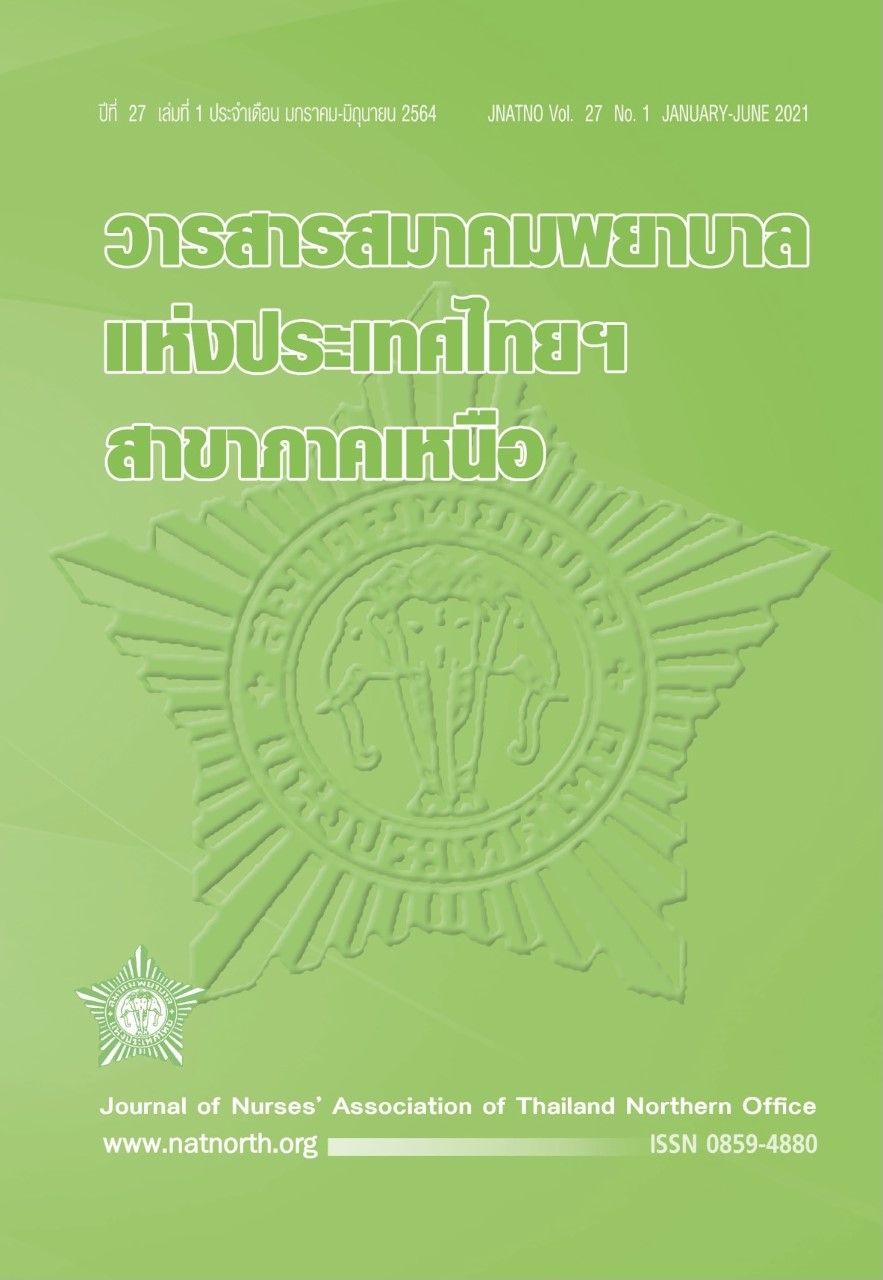Nurses’ Roles in the Prevention of Type 2 Diabetes in Children and Adolescents
คำสำคัญ:
โรคเบาหวานชนิดที่ 2, เด็กและวัยรุ่น, การป้องกันบทคัดย่อ
บทคัดย่อ
อุบัติการณ์การเกิดโรคเบาหวานชนิดที่ 2 ในเด็กและวัยรุ่นพบมากขึ้นทั่วโลกพร้อม ๆ กับโรคอ้วนซึ่งมีผลทำให้เซลล์ต่าง ๆ ในร่างกายไม่สามารถตอบสนองต่อฮอร์โมนอินซูลินได้เบาหวานที่เกิดในเด็กและวัยรุ่นนำไปสู่การเกิดโรคแทรกซ้อนต่าง ๆ ที่รุนแรงได้ปัจจัยที่เกี่ยวข้องกับการเกิดโรคเบาหวานชนิดที่2 ในเด็กและวัยรุ่น ได้แก่ ภาวะอ้วน พฤติกรรมการบริโภคอาหาร กิจกรรมทาง
กายหรือการออกกำลังกาย ภาวะเครียด พันธุกรรม สื่อและเทคโนโลยีการป้องกันเป็นสิ่งสำคัญที่จะทำให้ลดโอกาสเสี่ยงต่อการเกิดโรคเบาหวานชนิดที่2 ที่จะเกิดขึ้นในเด็กและวัยรุ่นได้พยาบาลแผนกผู้ป่วยนอกเป็นส่วนหนึ่งของทีมสหวิชาชีพที่มีบทบาทสำคัญเกี่ยวกับการป้องกันโรคเบาหวานชนิดที่ 2 ในเด็กและวัยรุ่น เช่น การคัดกรองโรคเบาหวานชนิดที่2ในเด็กและวัยรุ่นกลุ่มเสี่ยงการปรับเปลี่ยน วิถีชีวิตและพฤติกรรมสุขภาพด้านโภชนาการ การออกกำลังกายและการมีกิจกรรมทางกายที่เหมาะสม รวมทั้งควบคุมอารมณ์โดยใช้หลักการให้ความรู้และสร้างทักษะการดูแลตนเองเพื่อป้องกันการเกิดโรคเบาหวาน และการช่วยเหลือสนับสนุนให้ดูแลตนเอง ความตระหนักของพยาบาลในการป้องกันโรคเบาหวานชนิดที่ 2 สามารถช่วยให้เด็กและวัยรุ่นมีแนวทางในการป้องกันการเกิดโรคได้ บทความวิชาการนี้มีวัตถุประสงค์เพื่อนำเสนอบทบาทของพยาบาลแผนกผู้ป่วยนอกในการป้องกันโรคเบาหวานชนิดที่2ในเด็กและวัยรุ่น พยาบาลผู้ที่มีส่วนเกี่ยวข้องในการดูแลเด็กและวัยรุ่นสามารถนำไปประยุกต์ใช้เป็นแนวทางในการป้องกันโรคเบาหวานชนิดที่ 2 เพื่อให้เด็กและวัยรุ่นเติบโตอย่างมีคุณภาพชีวิตที่ดีต่อไป
เอกสารอ้างอิง
เอกสารอ้างอิง
International Diabetes Federation [IDF]. International Diabetes Federation Annual
Report 2017; 2017. [cited July 31, 2020]. Available from: https://www.idf.org/our-
activities/advocacy- awareness/resources-and-tools/149-idf-annual-report-2017.html
Aekplakorn W, Chariyalertsak S, Kessomboon P, Assanangkornchai S, Taneepanichskul S,
Putwatana P. Prevalence of Diabetes and Relationship with Socioeconomic Status in
the Thai Population: National Health Examination Survey, 2004–2014. JDR 2016:1-8.
สมาคมโรคเบาหวานแห่งประเทศไทยในพระราชนูปถัมภ์สมเด็จพระเทพรัตนราชสุดาฯสยามบรม
ราชกุมารี.แนวทางเวชปฏิบัติสำหรับโรคเบาหวาน 2560. พิมพ์ครั้งที่ 3. ปทุมธานี: ร่มเย็น มีเดีย;
กัลยาณี โนอินทร์. ภาวะน้ำหนักเกินและโรคอ้วนในวัยเรียนและวัยรุ่นไทย.วารสารพยาบาลทหารบก
;18(ฉบับพิเศษ):1-8.
วราพรรณ วงษ์จันทร. ความรอบรู้ทางสุขภาพกับการป้องกันโรคเบาหวานชนิดที่ 2 ในเด็กวัยเรียน.
วารสารพยาบาลทหารบก 2562;20(2):1-9.
Xu H, Verre MC. Type 2 diabetes mellitus in children. Am Fam Physician 2518;98(9):590-94.
Copeland KC, Silverstein J, Moore KR, et al. Management of newly diagnosed type 2
diabetes mellitus (T2DM) in children and adolescents. AAP 2013;131(2):364-82.
ชมรมต่อมไร้ท่อเด็กและวัยรุ่นแห่งประเทศไทย. สถานการณ์โรคเบาหวานชนิดที่ 2 ในเด็กไทยและแนว
ทางการรักษา 2562.[เข้าถึงเมื่อ 18 สิงหาคม 2563]. เข้าถึงได้จาก www.thaipedendo.org.
กรรณิการ์ พุ่มทอง. ความก้าวหน้าในการพัฒนายารักษาโรคเบาหวาน.วารสารหมอยาไทยวิจัย 2558;1(1):24-35.
Reinehr T. Type 2 diabetes mellitus in children and adolescents. World J Diabetes 2013:270-81.
Chiang JL, Maahs DM, Garvey KC, Hood KK, Laffel LM, Weinzimer SA, Walfsdorf JI,
Schatz D. Type 1 Diabetes in Children and Adolescent: A position Statement by the
American Diabetes Association. Diabetes Care 2018;41(9):2026-44.
Salsberry P, Tanda R, Anderson SE, Kamboj MK. Pediatric Type2 Diabetes: Prevention
AndTreatment Through a Life Course Health Development Framework. In: Halfon
N, Forrest C B,Lerner R M, Faustman E M, editors. Handbook of life Course Health
Development. Springer;2018:197-236.
สำเภา แก้วโบราณ นิภาวรรณ สามารถกิจ และเขมารดี มาสิงบุญ. ปัจจัยทำนายพฤติกรรมป้องกัน
โรคเบาหวานในวัยรุ่นที่มีภาวะเสี่ยงต่อโรคเบาหวานในจังหวัดสมุทรปราการ. วารสารการพยาบาล
และการดูแลสุขภาพ 2562;37(2):218-27.
Abdulah A, Peeters A, Courten M D, Stoelwinder J. The magnitude of association
betweenoverweight and obesity and the risk of diabetes: A meta-analysis of
prospective cohort studies. Diabetes Res Clin Prac 2010;89(3):309-19.
กรมควบคุมโรค กระทรวงสาธารณสุข. รายงานประจำปี 2558. นนทบุรี: สำนักงานกิจการโรงพิมพ์
องค์การสงเคราะห์ทหารผ่านศึกในพระบรมราชูปถัมภ์; 2558.
สำนักงานสถิติแห่งชาติ กระทรวงดิจิตัลเพื่อเศรษฐกิจและสังคม. การสำรวจพฤติกรรมการบริโภค
อาหารของประชากร พ.ศ.2560. 2561. [เข้าถึงเมื่อ30 พฤษภาคม 2563]. เข้าถึงได้จาก:
http://www.nso.go.th/sites/2014/DocLib13
มโนลี ศรีเปารยะ เพ็ญพงษ์. พฤติกรรมการบริโภคอาหารของกลุ่มนักเรียนและนักศึกษาในจังหวัด
สุราษฎร์ธานี. วารสารวิทยาการจัดการมหาวิทยาลัยราชภัฏสุราษฎร์ธานี 2559;3(1):109-26.
ศรีบังอร สุวรรณพานิช. ปัจจัยที่มีผลต่อพฤติกรรมการบริโภคอาหารของนักศึกษาสถาบันการพลศึกษา
วิทยาเขตกระบี่. วารสารวิชาการการพลศึกษา 2555;4(1):29-43.
สำนักงานคณะกรรมการพัฒนาเศรษฐกิจและสังคมแห่งชาติ.รายงายประจำปี 2557. กรุงเทพฯ:
สำนักงานกองทุนสนับสนุน การสร้างเสริมสุขภาพ (สสส.);2557.
อรุณี ไรปิ่น ยุนี พงศ์จตุรวิทย์ และนฤมล ธีระรังสิกุล.ความคิดเห็นและการปฏิบัติของมารดาบุตรวัย
ก่อนเรียนที่มีภาวะโภชนาการเกิน.วารสารมหาวิทยาลัยนราธิวาสราชนครินทร์ 2555;4(2):1-15.
วราภรณ์ แสงรัสมี. พฤติกรรมการบริโภคอาหารจานด่วนของนิสิตระดับปริญญาตรี
มหาวิทยาลัยเกษตรศาสตร์[วิทยานิพนธ์]. กรุงเทพฯ: มหาวิทยาลัยเกษตรศาสตร์; 2558.
สมจิต นคราพานิช รัตนา พึ่งเสมา และกนกวรรณ สุวรรณปฏิกรณ์. ผลของโปรแกรมการเสริมสร้าง
พลังอำนาจในการส่งเสริมสุขภาพต่อพฤติกรรมการบริโภคอาหาร พฤติกรรมการออกกำลังกายและ
ภาวะโภชนาการของนักเรียนชั้นมัธยมศึกษาตอนต้น. วารสารพยาบาลสาธารณสุข 2555;26(1):32-
สืบตระกูล ตันตลานุกุล และปราโมทย์ วงศ์สวัสดิ์. การดูแลเฝ้าระวังความเครียดในวัยรุ่น. วารสาร
เครือข่ายวิทยาลัยพยาบาลและวิทยาลัยการสาธารณสุขภาคใต้ 2562;6(2):279-85.
ไพบูลย์ จาตุรปัญญา.เบาหวานกับการรักษาตนเอง. กรุงเทพฯ:รวมทรรศน์การพิมพ์; 2554.
World Health Organization, 2016. Global Report on Diabetes. World Health
Organization http://www.who.int/iris/handle/10665/204871.
อรอนงค์ บุรีเลิศ นพรัตน์ ส่งเสริม และภัทรภร เจริญบุตร. รูปแบบการปรับเปลี่ยนพฤติกรรมการ
ป้องกันการเกิดโรคเบาหวานชนิดที่ 2 ในเด็กประถมศึกษา. วารสารวิทยาศาสตร์และเทคโนโลยี
หัวเฉียวเฉลิมพระเกียรติ 2561;4(2):20-29.
Kanfer FH, Gaelick L. Self-management methods. In KanferFH. Goldstein AP.(Eds.).
Helping people Change. New York: Pergamon Press;1988:283-238.
ชูศักดิ์ ยืนนาน. แนวคิดการพยาบาลโดยเน้นครอบครัวเป็นศูนย์กลางในการดูแลผู้ป่วยเด็กในภาวะ
วิกฤตและเรื้อรัง. วารสารสมาคมพยาบาลแห่งประเทศไทยฯ สาขาภาคเหนือ 2560;23(2):59-68.
เขมารดี มาสิงบุญ, สายฝน ม่วงคุ้ม และสุวรรณี มหากายนันท์. ปัจจัยที่มีความสัมพันธ์กับพฤติกรรม
ป้องกันการเกิดโรคเบาหวานในกลุ่มเสี่ยงต่อการเป็นเบาหวาน. วารสารพยาบาลกระทรวงสาธารณสุข
;27(2):214-27.
สุพิชญา หวังปิติพาณิชย์, แสงทอง ธีระทองคำ และมะลิวัลย์ ภาคพยัคฆ์. ผลของโปรแกรมออกกำลัง
กายแบบแรนสามสิบต่อพฤติกรรมการป้องกันโรคเบาหวาน ดัชนีมวลกาย และค่าน้ำตาลในเลือดปลาย
นิ้วของผู้ที่เสี่ยงต่อเบาหวาน. รามาธิบดีพยาบาลสาร 2560;23(3):358-70.
ดาวน์โหลด
เผยแพร่แล้ว
รูปแบบการอ้างอิง
ฉบับ
ประเภทบทความ
สัญญาอนุญาต
บทความที่ได้รับการตีพิมพ์เป็นลิขสิทธิ์ของสมาคมพยาบาลแห่งประเทศไทยฯ สาขาภาคเหนือ
เนื้อหาและข้อคิดเห็นใดๆ ที่ตีพิมพ์ในวารสารสมาคมพยาบาลฯ ถือเป็นความรับผิดชอบของผู้เขียนเท่านั้น ผู้เขียนบทความต้องศึกษารายละเอียดหลักเกณฑ์การจัดทำต้นฉบับตามที่วารสารกำหนด และเนื้อหาส่วนภาษาอังกฤษต้องได้รับการตรวจสอบจากเจ้าของภาษามาแล้ว


